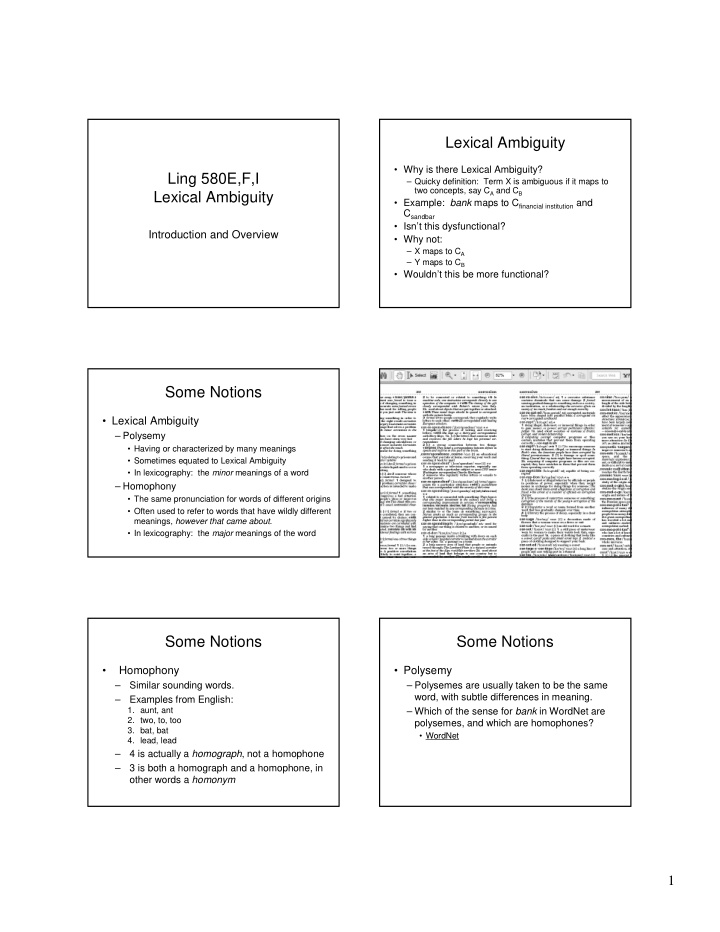



Lexical Ambiguity • Why is there Lexical Ambiguity? Ling 580E,F,I – Quicky definition: Term X is ambiguous if it maps to two concepts, say C A and C B Lexical Ambiguity • Example: bank maps to C financial institution and C sandbar • Isn’t this dysfunctional? Introduction and Overview • Why not: – X maps to C A – Y maps to C B • Wouldn’t this be more functional? Some Notions • Lexical Ambiguity – Polysemy • Having or characterized by many meanings • Sometimes equated to Lexical Ambiguity • In lexicography: the minor meanings of a word – Homophony • The same pronunciation for words of different origins • Often used to refer to words that have wildly different meanings, however that came about . • In lexicography: the major meanings of the word Some Notions Some Notions • Homophony • Polysemy – Similar sounding words. – Polysemes are usually taken to be the same word, with subtle differences in meaning. – Examples from English: – Which of the sense for bank in WordNet are 1. aunt, ant 2. two, to, too polysemes, and which are homophones? 3. bat, bat • WordNet 4. lead, lead 4 is actually a homograph , not a homophone – – 3 is both a homograph and a homophone, in other words a homonym 1
Some Notions Some Notions • Synonymy • Example plesionyms (from Hirst 1995): – the semantic relation that holds between two 1. lie words that can (in a given context) express 2. falsehood the same meaning 3. untruth – Absolute synonymy is said by some to not 4. fib exist 5. misrepresentation – Terms that are near-synonyms, differing only in certain contexts, are called plesionyms (Hirst 1995) The Paths to Homophony The Paths to Homophony • How do polysemes come about? • How do homophones come about? – Historical convergences: – May evolve from metaphoric uses. • [bæt] Take tiger . (WordNet) – bat (as in mammal) from ME bakke for flying rodent , 1. bat (as in baseball) from Celtic bata for stick 2. • [nait] 1. night – from Old High German 2. knight – also from Old High German – Historical divergences – Metaphoric uses (polysemes) that gradually become different meanings – Borrowings and new words – gate Selecting a vocabulary Totals by Onsets and Nuclei 45 Words Concepts 40 35 30 X C 1 # of forms 25 20 Y C 2 15 10 5 Z C 3 0 hnl g nl nplh nqh nkh hny nch dh hm nrh nph None plh nth hn ntsh rh ntxh xy nq npl nk qh ch np hl ny nc ntx pl f v nr n ph Onset r nts z kh aw tsh m Nucleus nt txh d th h q x y s ai c tx p ts k l t 2
Ratio (w/o to whole space) Hmong Comparisons Normalized 0.7 0.6 0.35 0.5 0.30 0.4 0.25 Whole space 0.3 0.20 w/o homop 0.15 0.2 w/ homop 0.10 0.1 0.05 0 0.00 4 5 6 7 8 9 1 0 1 1 4 5 6 7 8 9 10 # feat ures # Fea t ur e s German Ratio (w/o to whole space) German Comparisons 1 Normalized 0.45 0.4 0.35 0.25 0.3 0.20 0.25 0.2 0.15 Whole space 0.1 5 w/ o homop 0.10 0.1 0.05 0.05 0 4 5 6 7 8 9 1 0 1 1 1 2 1 3 1 4 1 5 1 6 1 7 1 8 0.00 # f eat ures 3 4 5 6 7 8 9 10 11 12 13 14 15 16 17 18 # Feat ur e s 3
Recommend
More recommend